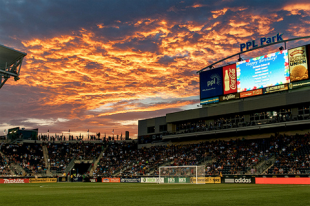Photo: Garen Meguerian
Earlier this week, PSP editor Dan Walsh wrote about his soccer culture shock in moving from Philly to DC. New PSP contributor Nate Emeritz writes about his experience moving in the other direction, from DC to Philly.
I’ve seen these fields before.
Since moving to Philadelphia from Washington, DC, I’ve played on grass, turf, and hardwood surfaces. They’re familiar, as are the developments in the local game.
I grew up playing on DC-area fields that could only occasionally be referred to as grass fields, but were appropriately named Turkey Thicket, Bull Run, and Fort Stevens. Concussions were, as Dan Walsh suspected, a recurrent event (at least for me). So too were surface dangers such as rocks and, once, a metal post, cut off at field level, that sent me to the hospital for twenty-odd stitches. Occasionally I also played on manicured grass fields, the old, rug-on-concrete turf, and in basketball gyms.
The youth leagues and players wanted to be serious, but the conditions often were not. I left DC with a prominent scar and experience playing on rocks (or worse).
Around the same time that I began my relocation to Philadelphia by way of New York, FieldTurf began to replace grass on fields across the country. In New York, soccer fields were transformed from syringe-speckled dust bowls to flat, consistent, slideable, FieldTurf oases. I love grass fields but will take a city full of predictably level turf over one with natural surfaces that depend on the weather, the city’s groundskeepers, and budgetary whims.
At the same time that turf spread, DC United dominated, New York and New Jersey nominally shared the Metrostars, MLS expanded, televised soccer coverage increased, and soccer was everywhere in New York: I played a 7 a.m. pick-up game, 7v7 games until midnight during the week, indoor futsal with a weighted ball on Saturdays, and the long-standing citywide Cosmopolitan League on Sundays.
Players of all degrees of talent came from around the globe and played to win every meaningless challenge; New York provided the fields. I left New York with another prominent scar and experience playing on new surfaces.
My earliest experience with Philadelphia-area soccer was playing against the national powerhouse Delco club team. My club even lost a player who transferred to Delco and traveled to games from DC, which struck me as a strong indication of seriousness on the parts of both the player and Delco.
But I’m struck by the disconnect between the competitiveness of a Philadelphia-area youth soccer system that supports Delco and developed a feisty, talented player like Ben Olsen, and the Casa League which doesn’t allow slide tackles. Soccer became popular in Philadelphia and New York around the same time, but the Cosmopolitan League now dwarfs this area’s adult league.
It’s not the size of the cities: Philadelphia is smaller than New York but larger than DC. Peter Stuyvesant and William Penn developed New York and Philadelphia during the second half of the 17th century, while DC developed roughly 100 years later. Since then, Philadelphia has lost prominent contests to be the commercial center to New York and seat of federal government to DC.
Dan described Philadelphians as “real” in contrast to Washingtonians. This led me to ask some existential questions of myself and consider the soccer-related symptoms of a city that proudly identifies itself with a defective product.
In the 20th century, Bethlehem Steel and the Atoms—not to mention the German Americans, the Nationals and the Ukrainian Nationals—arguably made Philadelphia the center of United States soccer. Philadelphia competed with and often beat teams from New Jersey, New York, and DC, but it then fell off the amateur and professional soccer maps until the second decade of MLS.
The Union and PPL Park have resurrected Philadelphia’s professional soccer status. Amateur soccer is alive and well in the Casa League. Since I moved to Philadelphia, Mayor Nutter has outed himself as a soccer fan, and Cole Hamels’s foundation donated money to build a turf soccer field. I have played pickup games on turf, futsal in a basketball gym, and in a full-sided league on a decent grass field.
The game here is the same as I have played elsewhere (except for slide tackling rules), and the fields are the same. Not everyone agrees on the proper balance of hustle, contact, competitiveness, enjoyment, individual displays of skill, and team cooperation. This leads to tension, occasionally along age, talent, or ethnic lines, occasionally between veterans of Philadelphia soccer and newcomers. Tension on the soccer field is common in my experience, and it often precedes change.
Philadelphia is making many of the same changes that New York and DC have. The timing of these changes may reflect competitive or cultural differences which have previously played out in the commercial and political arenas. But the force behind these changes reflects more than localized attitudes- it reflects a national transition in the way cities support soccer and in the American soccer identity.
I have no new scars in Philadelphia, but suspect that scars, turf, and the new national attitude toward soccer are coming, as Philadelphia again follows New York and DC.


Hello Nate,
For adult amateur soccer in Philly, feel free to check out the United Soccer League. While we don’t have 5 divisions of play anymore, our clubs run with the best of them, on both the mens and womens sides. And we allow slide tackling…
Thanks Tom. I appreciate your commenting and the recommendation. If I don’t join a USL team, perhaps I’ll see you in Open Cup play.
Also to be clear, while I prefer the USL approach, I wasn’t criticizing Casa’s rules about sliding. I’ve never played in an outdoor league that didn’t allow slide tackling – particularly not one of the larger local leagues – so it struck me as distinctive.